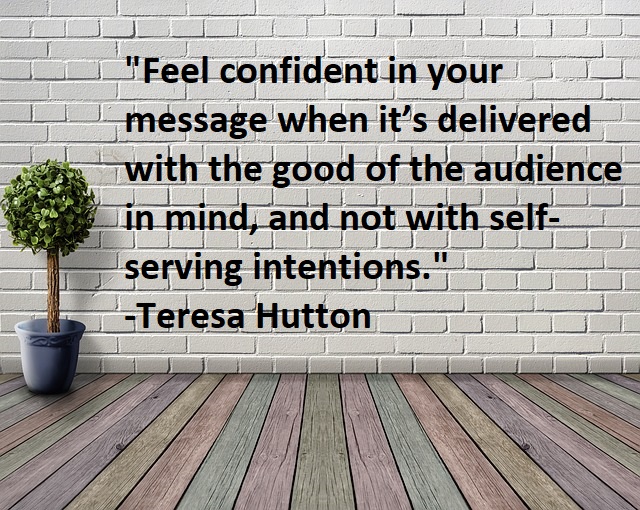When you hear the word “persuade”, what comes to mind? For a lot of us, it comes with a negative connotation, akin to manipulation.
But it doesn’t have to.
Let’s explore what positive benefits persuasion can have, followed by a framework for persuasion with positive intent.
According to Merriam-Webster the definitions of persuade and manipulation are as follows:
persuade: 1. To move by argument, entreaty, or expostulation to a belief, position, or course of action.
“persuade, v.” Merriam-Webster, https://www.merriam-webster.com/dictionary/persuade, accessed October 20, 2019
manipulate: 2b. to control or play upon by artful, unfair, or insidious means especially to one’s own advantage
“manipulate, v.” Merriam-Webster, https://www.merriam-webster.com/dictionary/manipulate, accessed October 20, 2019
When I look at the definition of persuade, it is neutral. You could persuade someone with good intention, or with ill will. But manipulation usually benefits the manipulator, by unscrupulous means.
We’re persuaded every day. When we look at online reviews and decide for or against buying a product or eating at a particular restaurant, we’ve likely been persuaded to do so. We still made the decision, but the reviews of others persuaded us one way or the other. In this case, it’s unlikely we’ve been manipulated.
When I was an undergraduate student, a TA told me I had what it takes to go to graduate school. He persuaded me to believe that and I ended up getting my master’s degree. I’m happy that he persuaded me to that course of action because it ended up opening some opportunities for me. And, there was nothing in it for him. He only had my best interest in mind.
I often work with people to persuade them to a belief – particularly a belief in their capabilities, potential, and ability to make sound decisions. I’ve never had someone give me feedback like, “Now look what you’ve done. Now I have to believe in myself!” It’s always a sigh of relief, and a smile of excitement at what the future has in store.
Persuasion has its place. Think of yourself as a messenger. When the message you want to communicate is for positive change, and is done in the best interest of others (not just to serve yourself), then you can use persuasion confidently.
Let’s focus on persuading with positive intent as we look into a framework to help us in persuading others. The formula is Know-Think-Feel-Do. The basic concept has been around for decades, but this particular flavor comes from a podcast from Brendon Burchard, “Influencer Series: How to Persuade Others”, September 16, 2019.
Know
What do you want your audience or person you are communicating with to know? There are often facts or data that are important to the reasons you are presenting your argument in the first place. Many times we try to just use the data alone to persuade, but it’s not always enough to move people to action or a new belief.
Think
How does your audience need to think of themselves in order to come around to a new belief or course of action? Do they need to think of themselves as leaders? Effective team members? High achievers? Mentors? Let them know.
Feel
What does your audience need to feel about your proposal? Maybe you want them to feel connected, engaged, inspired, or educated. This emotional side compliments the thinking side.
Do
What is it you want the audience to do? Accept your design proposal? Give you feedback? Buy your product? Inspire others? Join your organization? This is a call to action.
The Know-Think-Feel-Do framework is good to use at any level of leadership when you are leading change, or proposing something new. It’s especially useful if you are not in a position of authority and want to influence or persuade others in some way. This happens at work when we’re on a team but are not the leader or manager. This is also usually the case when were part of a volunteer organization where no one has leverage over another. Even if you do have authority over others, this is still a good framework to get them on board with your new vision or idea.
Just like you read a review and make your own decision about buying a product, you can feel comfortable in knowing your audience will do the same when you lay out your case for inspiring a belief or moving them to action. Because we are going about persuading others with positive intent and not to serve ourselves, we can be confident in our actions.
Give the Know-Think-Feel-Do framework a try. You have something important to share, and this is one approach to accomplishing that.
Lastly, respect your audience’s choice. They may be persuaded or they may not. At least they have a little more information and perspective than they had before. And, you never know – they may come around to your proposal in the future (so best to be respectful of their decision).
tl;dr
Persuasion is not manipulation. Persuasion can be used for good. Using the Know-Think-Feel-Do model we can lay out a case for inspiring a belief or moving someone to action. Think of yourself as a messenger, and feel confident in your message when it’s delivered with the good of the audience in mind, and not with self-serving intentions.
engineer your life
- Think of a situation where you can use the Know-Think-Feel-Do model. Write a draft of each part.
- Go through this article and identify the Know-Think-Feel-Do parts. Full disclosure: I’m attempting to persuade you to try using a persuasion framework. 🙂
